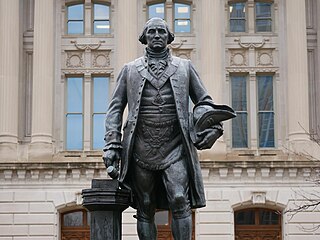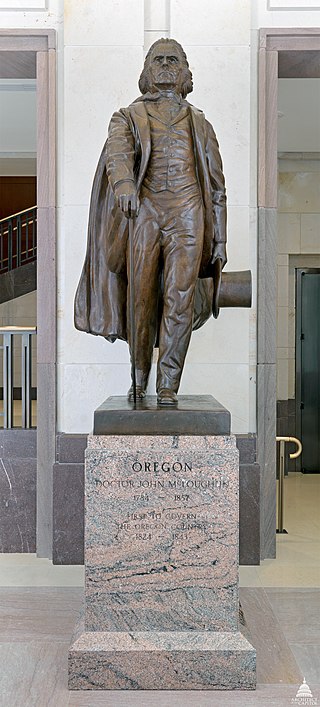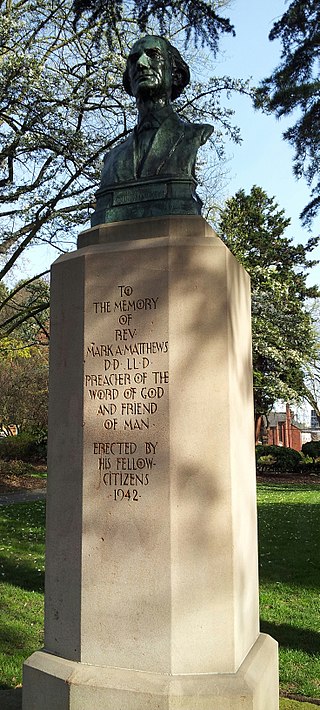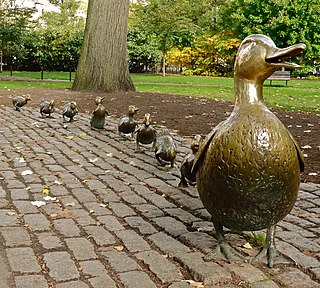
Cyrus Edwin Dallin was an American sculptor best known for his depictions of Native Americans. He created more than 260 works, including the Equestrian Statue of Paul Revere in Boston; the Angel Moroni atop Salt Lake Temple in Salt Lake City; and Appeal to the Great Spirit (1908), at the Museum of Fine Arts, Boston. He was also an accomplished painter and an Olympic archer.

George Washington is a public artwork by American sculptor Donald De Lue, located on the grounds of the Indiana Statehouse, in Indianapolis, Indiana, United States. The bronze statue of George Washington that occupies the Indiana Statehouse south lawn is one of several copies of a 1959 original wax cast at the Modern Art Foundry in Long Island, New York.

Bonshō, also known as tsurigane or ōgane are large bells found in Buddhist temples throughout Japan, used to summon the monks to prayer and to demarcate periods of time. Rather than containing a clapper, bonshō are struck from the outside, using either a handheld mallet or a beam suspended on ropes.

Theodore Roosevelt, Rough Rider is a toppled bronze sculpture, not currently restored, by American artist Alexander Phimister Proctor, formerly located in the South Park Blocks of Portland, Oregon in the United States. The equestrian statue was completed in 1922 and depicts Theodore Roosevelt as the leader of the cavalry regiment that fought during the Spanish–American War called the Rough Riders.

Coming of the White Man is a bronze sculpture by American artist Hermon Atkins MacNeil, installed in Washington Park, Portland, Oregon in the United States. The statue was gifted to the City of Portland in 1904 by former mayor David P. Thompson and installed the following year. It depicts two Native American men, including Chief Multnomah, looking towards the Columbia River upon the arrival of Lewis and Clark.

Running Horses is an outdoor 1986 bronze sculpture by Tom Hardy, located on the Transit Mall in downtown Portland, Oregon. It is part of the City of Portland and Multnomah County Public Art Collection courtesy of the Regional Arts & Culture Council.
Perpetuity is an outdoor 1970 sculpture by Alexander von Svoboda, located in Portland, Oregon.

John McLoughlin, also known as Dr. John McLoughlin, is a bronze sculpture of John McLoughlin by Alexander Phimister Proctor and completed by his son Gifford MacGregor Proctor. One statue is installed at the Oregon State Capitol grounds in Salem, Oregon; another is installed in Washington, D.C., as part of the National Statuary Hall Collection.

Jason Lee, also known as Reverend Jason Lee, is an outdoor bronze sculpture of Jason Lee, located in Salem, Oregon, United States. It was designed by Alexander Phimister Proctor, who died in 1950 when only the work's model was finished. His son Gifford MacGregor Proctor completed the sculpture between 1950 and 1953. The one installed on the grounds of the Oregon State Capitol is a duplicate of a bronze statue unveiled in the United States Capitol in 1952.

A Donkey, 3 Rocks, and a Bird., also known as Donkey, Bird and Rocks and Donkey, Three Rocks, and a Bird, is an outdoor 1992 sculpture by Brad Rude, installed at Catlin Gabel School in West Haven-Sylvan, a census-designated place in Washington County and the Portland metropolitan area, in the U.S. state of Oregon.

Untitled is an outdoor 1952 fountain and sculpture by Tom Hardy, installed at the Park Blocks in Eugene, Oregon, United States.
The Quest is an outdoor 1983 sculpture of Alice Biddle by Kirk St. Maur, installed on the Oregon State University campus in Corvallis, Oregon, in the United States.

The Falconer is a bronze sculpture by James Lee Hansen. Dates for the abstract piece range from the 1960s to 1973.
Sasquatch Pushing Over a House is an outdoor 1982 sculpture by Richard Beyer, installed Seattle's University Playground, in the U.S. state of Washington.

Dr. Mark A. Matthews is an outdoor 1941 bust depicting the minister and city reformer of the same name by Alonzo Victor Lewis, installed in Seattle's Denny Park, in the U.S. state of Washington.

Three Piece Reclining Figure: Draped 1975 is a bronze sculpture by Henry Moore, catalogued as LH 655. It is approximately 4.7m long. Seven casts and an artists proof were made. Three publicly exhibited casts are situated in the Sodra Kungsgatan in Gävle, Sweden, at the Massachusetts Institute of Technology in Boston, USA, and at the Henry Moore Foundation in Perry Green, Hertfordshire.

The Lincoln Goodale Monument, is an 1888 bust depicting the physician of the same name, installed in Columbus, Ohio's Goodale Park, in the United States.

Make Way for Ducklings is a sculpture by Nancy Schön, which recreates the duck family in Robert McCloskey's children's classic Make Way for Ducklings.
The Peace Child of Hiroshima is a 1991 bronze sculpture by Daryl Smith, installed at the University of Utah in Salt Lake City, Utah, United States.

George Washington is an outdoor equestrian statue by the Scottish-American sculptor J. Massey Rhind located in Washington Park in Newark, New Jersey. It depicts General George Washington saying farewell to the troops of the Continental Army on November 2, 1783, and was dedicated on the anniversary of that event in 1912.

















